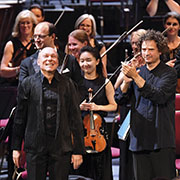Dieter Ammann’s „The Piano Concerto. Gran Toccata“ received its premiere in August 2019 in London. The initiative for the work came from the pianist Andreas Haefliger. In working on the piece the composer pushed forward into the open bar by bar.
Dieter Ammann has composed his Piano Concerto for the pianist Andreas Haefliger which receives its premiere in August in the British capital. The original working title was “no templates”, the composer says, “which primarily means an openness of thought in the approach to this genre, but also an openness in relation to the variety of means used”. An approach “without a pattern” has long characterised the compositions of Dieter Ammann, whose notation pushes forward with meticulous precision and detail, bar by bar into the open. His works are the result of an intertwining of varied sound and performing situations, “not a collage-like, but a dramaturgically directed music with ‘character’. The power of the dramaturgy and the coherent organisation of time associated with it form a parenthesis in which a contrasting tonal topography unfolds, whereby the various structural elements (for example, different tone systems) are capable of entering into a fruitful discourse.”
In the broad field of tension between the individual and the collective, which traditionally characterises the genre, the composer is concerned with the most diverse forms of playing. “So, for example, in the solo part there will be choices between several functions. The conventional roles of the piano both as accompanist to the orchestral action and of the unaccompanied individual are only two possible formats, whereby in the latter the interdependent flow of material and energy often continues subcutaneously, so that the solo instrument cannot ‘flee’ into the subjective or even the impersonal. Further function categories are the common solo accompagnato, which has its place, as does the ‘orchestral piano’ mentioned above. New terrain is opened up by expanding the action spectrum of the solo instrument. In addition there is a kinetic component, almost a ‘corporal subtext’, so that the music cannot simply be reduced to the realisation of the musical text, but also reveals a visual side from the performative – something which means additional information content in the reception (particularly in the concert situation). This optical aspect, such as in the transfer and recording of impulse chains (that is the actual ‘concertare’) can in the process even become primary information if in fact the solo part is blurred, concealed, swallowed or successively dissolved in the overall texture. The close interlocking of the functions of piano and orchestra has the effect that the moment of virtuosity inherent in the genre as the ‘sociological model’ does not remain limited to the solo instrument, but is also strongly echoed in some of the orchestral passages.”
Marie Luise Maintz
(from “[t]akte” 1/2019)



